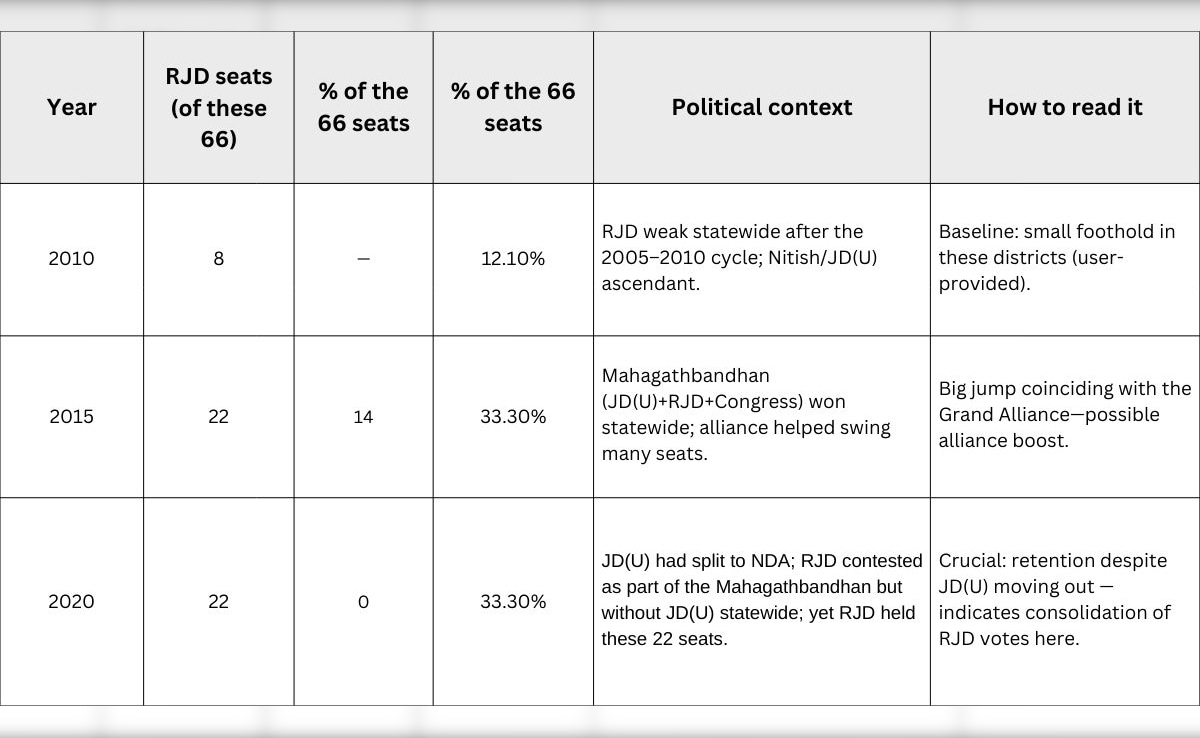
- Tejashwi Yadav launched a five-day Bihar Adhikar Yatra post the 16-day Voter Adhikar Rally with Rahul Gandhi
- The Yatra covered 10 districts, targeting 22 key RJD constituencies
- RJD won 22 of 38 seats in these districts in 2020 and 2015
In the ever-shifting landscape of Indian politics, where allegiances shift like desert sands, the recent actions of Tejashwi Yadav, the leader of the Rashtriya Janata Dal (RJD) and chairman of the Mahagathbandhan, reveal a depth of strategy interwoven with the fabric of personal ambition. His decision to embark on a five-day Bihar Adhikar Yatra, immediately following a 16-day Voter Adhikar Rally alongside key ally Rahul Gandhi, raises critical questions: Was this an act of ego, or a calculated manoeuvre rooted in the intricate tapestry of electoral strategy?
At first glance, the timing of this Yatra seems telling. Tejashwi's initiative could be interpreted as a personal statement - a declaration of his political identity in a coalition that, while united in its opposition to the ruling party, has struggled with the nuances of shared leadership. The absence of an official endorsement from Congress as the Chief Ministerial candidate may well have stung his aspirations. In the realm of politics, where perceptions often shape reality, this omission could be seen as a slight, prompting Tejashwi to assert his relevance and authority through direct engagement with the electorate.
22 Key Seats
Yet, to reduce this Yatra to mere ego would be to overlook the deeper motivations at play. Consider the route of the five-day Bihar Adhikar Rally: the 10-district route Tejashwi Yadav covered (Jehanabad, Nalanda, Patna, Begusarai, Khagaria, Supaul, Saharsa, Madhepura, Vaishali, Samastipur). Tejashwi's choice to target 22 key constituencies - strongholds of the RJD that were conspicuously absent from the Voter Adhikar Rally route - speaks to a strategic foresight that transcends personal ambition. These districts are not just geographical markers; they represent the lifeblood of his party's electoral base. By focusing his efforts on these key areas, Tejashwi aims to rekindle the loyalty of voters who may feel neglected in the broader coalition narrative.
RJD's Surging Strike Rate
The RJD's surging strike rate reflects the success of this electoral strategy. In 2020, the RJD contested 38 seats in these 10 districts and won 22, a strike rate of 58 per cent. This was approximately three times its 2010 tally, when it contested 36 and won just eight, a strike rate of 22 per cent.
Consider nine of these 22 key constituencies. In the Vaishali district, the three key constituencies of the RJD are Raghopur (Tejashwi's constituency), Mahnar and Mohua. In Khagaria, the constituency of Alauli. In Begusarai, the constituency of Cheria-Bariarpur. In the Supaul district of Mithilanchal, the key constituency of Laukaha. In Madhepura district, the constituencies of Madhepura and Singrauli. In Samastipur district, the assembly constituency of Samastipur. And so one and so forth. Notice that these constituencies are geographically spread between the Mithilanchal region of north Bihar as well as South of the Ganges in South Bihar. Madhepura district is known for Yadav hegemony by the popular slogan: Rome hai Pope ka, Madhepura hai Gope ka (Gope is another name for the Yadav caste in Bihar)
Moreover, the RJD's historical significance in Bihar politics cannot be understated. The party's identity is intricately tied to the social and economic fabric of the state, particularly among Yadav, Muslim, and other marginalised communities. Tejashwi's Yatra is thus not merely a campaign for votes; it is a reaffirmation of the RJD's commitment to its foundational principles of social justice and equity. In a state where caste dynamics play a pivotal role in electoral outcomes, engaging directly with constituents can serve to reinforce a sense of belonging - a reminder that their voices remain central to the political discourse.

Aim To Galvanise RJD Supporters
In addition to these strategic imperatives, there is an undeniable current of urgency in Tejashwi's actions. Bihar, with its complex socio-political landscape, is a microcosm of larger national trends. As the 2025 assembly elections loom on the horizon, the stakes for all parties are exceedingly high. Tejashwi's proactive approach can be seen as a response to this urgency. By reinforcing his presence in these critical constituencies, he not only galvanises support but also positions himself as a leader who is both responsive and responsible - qualities that resonate deeply in a state often plagued by governance challenges.
Furthermore, the five-day Yatra embodies a narrative of resilience. In a political environment where alliances can be as fragile as they are necessary, Tejashwi's decision to carve out his path speaks volumes about his understanding of the electoral game. It is a testament to the idea that in politics, as in life, one must sometimes take bold steps to reclaim agency. His journey through Bihar is not merely a quest for votes; it is also an affirmation of identity, a reinvigoration of purpose, and a declaration that the RJD, under his stewardship, remains a formidable force.
In conclusion, Tejashwi Yadav's Bihar Adhikar Yatra is a multifaceted endeavour that encapsulates the complexities of political ambition, strategic necessity, and the quest for identity in a coalition framework. It is not simply a reaction to perceived slights but a calculated bid to strengthen ties with his base while asserting his relevance in the broader political narrative. As he traverses the landscapes of Bihar, he embodies the hopes and aspirations of many, proving that in the intricate dance of democracy, every step taken is both a statement and a strategy.

Alliance Effect vs Independent Retention
The 2015 spike was plausibly aided by alliance arithmetic. The Mahagathbandhan created a combined anti-NDA front that redistributed anti-NDA votes and reduced vote-splitting; that environment helped RJD convert more seats across many clusters. (Statewide RJD seat count jumped sharply in 2015.)
But the RJD holding 22 seats in 2020 is the stronger signal. Even after JD(U) moved to the NDA fold, RJD retained the same 22 seats in those 10 districts - that argues the 2015 gains were not purely a one-off alliance artefact but reflected actual vote consolidation (local organisation, candidate incumbency, social coalition: Yadavs, Muslims, some EBC pockets, plus Tejashwi's leadership). The retention despite an unfavourable realignment is the key evidence for "genuine gains."
What The Numbers Imply
The jump from 8 to 22 shows both opportunity and the effectiveness of a coalition in 2015 to amplify RJD reach. The maintenance of 22 in 2020 shows institutionalised vote transfer to RJD - voters continued to back RJD candidates even when the JD(U) exit removed the alliance-level advantage in many places.
For campaign strategy: Tejashwi's recent Bihar Adhikar Yatra across these districts aims to consolidate these gains further and reduce any residual volatility.
Track Latest News Live on NDTV.com and get news updates from India and around the world

